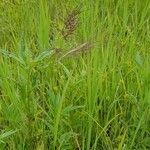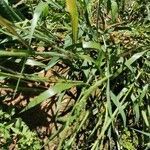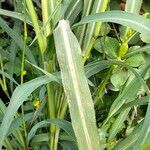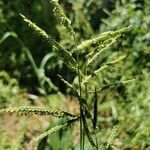Stout, often branched from the decumbent base; sheaths glabrous; blades 5–30 mm wide; infl 1–2.5 dm, erect, with usually 15–25 appressed or spreading branches 2–4 cm (to 6 cm in var. frumentacea), the longer ones rebranched; main axis and branches of the infl beset with stout, often papillate-based setae typically as long as or longer than the spikelets; spikelets 2.8–4 mm; second glume and sterile lemma variously scabrous, hispid, or hirsute to subglabrous, but the hairs usually not papillate-based, the glume awnless or nearly so; fertile lemma 2.5–3.5 mm, ca twice as long as wide, the short, soft beak withering, somewhat inflexed, sharply differentiated from the obtuse body, marked by a line of minute bristles at base; 2n=54. Native of Eurasia, widespread in the U.S., Can., and Mex. Two vars. with us:
Tufted annual, 0.25-1.00 m high; stoloniferous; hygrophyte. Leaf blade 70-350 X 1-20 mm; ligule absent. Inflorescence elongated, 60-220 mm long, of many racemes scattered up central axis, usually with short secondary branchlets at base; raceme 20-100 mm long, spikelets untidily 2-several-rowed. Spikelets 3-4(-7) x 1-2 mm, ovate-elliptic, dorsiventrally compressed, hispid; glumes unequal; upper glume as long as spikelet; glumes and lower lemma minutely hairy, nerves with long, rigid hairs. Florets 2; lower floret sterile, lower lemma usually awnless or sometimes with awn 5-35 mm long; upper floret bisexual, lemma 2-3 mm long, hard, entire, margins inrolled and clasping only edges of palea; anther 0.7-1.1 mm long. Flowering time Jan.-Apr.
Annual. Culms coarse, erect or geniculately ascending, 20–150 cm tall. Leaf blades linear, 5–40 × 0.2–1.2 cm, usually glabrous, smooth except for scabrous margins, apex acute. Inflorescence erect, lanceolate to ovate or pyramidal, 6–22 cm; racemes 2–10 cm, usually ascending, simple or the longest with inconspicuous branchlets near the base, rachis usually with tubercle-based setae, spikelets loosely to densely crowded. Spikelets green or purplish, ovate, 2.5–4 mm, spinulose along veins; lower glume ca. 1/3 as long as spikelet, acute; lower lemma sterile, herbaceous, acuminate or extended into an awn to 3 cm; upper lemma pale brownish at maturity, elliptic, 2–3 mm. Fl. and fr. summer and autumn. 2n = 36, 48, 54, 72.
Tufted annual 250-1 000 mm high; hygrophyte; stoloniferous. Leaf blade 70-350 x 4-20 mm, ligule absent. Inflorescence 60-220 mm long, elongated; raceme 20-100 mm long, untidily 2 to several-rowed, usually with short secondary branchlets at the base, not or inconspicuously compound. Spikelet 3-4(-7) x 1 to 2 mm, ovate-elliptic; glumes and lower lemma minutely hairy, nerves with long, rigid hairs; lower floret sterile; lower lemma usually awnless, sometimes with a awn 5-35 mm long; upper lemma 2 to 3 mm long (including short herbaceous apex); anther 0.7-1.1 mm long.
An annual grass It grows 1-1.5 m tall. It can be erect or lean over. The leaves are long and narrow and flat. They are about 35 cm long and 1 cm wide. The leaves do not have hairs except for a few hairs at the base. The flower arrangement is open and up to 25 cm long by 8 cm wide. The flower arrangement is pinkish. There are 3 or 4 irregular rows. The lower flower stalks are 10 cm long and they get shorter higher up. The spikelets are 2-4.5 mm long. It does not have a ligule or row of hairs where the leaf sheath joins the stem. One plant can produce 7000 seed.
Coarse annual; culms 25–100 cm. high, erect or spreading.. Leaf-blades 7–35 cm. long, 4–20 mm. wide; ligule absent; sheaths glabrous, rarely appressed hairy.. Inflorescence linear to ovate, 6–22 cm. long, the racemes untidily 2–several-rowed, the longest 2–10 cm. long usually with short secondary branchlets at the base.. Spikelets ovate-elliptic, mostly 3–4 mm. long, hispid; lower floret barren, acuminate or with an awn up to 5 cm. long; upper lemma 2–3 mm. long, including the short herbaceous tip.
Annual, hydrophyte, stoloniferous and tufted, up to 1 m high. Leaf blades 70-350 mm long, 4-20 mm wide; ligule absent. Spikelets 3 or 4(-7) mm long, 1-2 mm wide. Inflorescence 60-220 mm long; racemes untidily 2-to several-rowed, 20-100 mm long and usually with secondary branchlets at base; lower floret sterile; lower lemma usually awnless, rarely with an awn 5-10 mm long.
Annual; up to 1 m high; hydrophyte; stoloniferous and tufted. Leaf blades 70-350 x 4-20 mm; ligule absent. Flowers: inflorescence spike-like; 60-220 mm long; racemes untidily 2-to several-rowed; 20-100 mm long; base usually with secondary branchlets; spikelets 3-4(-7) x 1-2 mm; lower floret sterile; lower lemma usually not awned; rarely with awn 5-35 mm long.
Inflorescence 6–22 cm. long, linear to ovate; racemes untidily 2-several-rowed, the longest 2–10 cm. long usually with short secondary branchlets at the base.
Culms 25–100 cm. high, erect or ascending; ligule absent; leaf laminae 62–20 mm. wide.
Superior lemma 2–3 mm. long, including the short herbaceous apex.
Inferior lemma acuminate or with an awn up to 5 cm. long.
Spikelets mostly 3–4 mm. long, ovate-elliptic, hispid.
Coarse annual.













